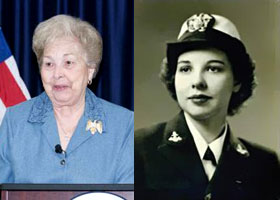
Winnie Breegle WAVE Code Talker
On Throw-back Thursday and in honor of Women’s History, here is a slightly reworked post from 2012 about Winnie Breegle, a World War II WAVE (Woman Accepted for Volunteer Emergency Service) and a Navajo code talker, who didn’t happen to be a Navajo.
90-year-old Winnie Breegle spoke at the 2012 Women’s History Month celebration at the Naval Surface Warfare Center in Panama City, FL. She had quite a story to tell. Not only was she a WAVE (Woman Accepted for Volunteer Emergency Service) in World War II but she was also a “code talker,” trained to understand Navajo code as a cryptographer.
In World War II, the code talkers were largely a group of more than 400 Marines who were bilingual Navajo speakers. By using a spoken Navajo code, they were able to dramatically speed up communications while being undecipherable to the Japanese. Most code talkers were Navajo, but as there were too few Navajo speakers, a program was set up to train WAVES to understand the code talkers. Winnie Breegle was one of the WAVES to become a code talker.
WWII WAVE, Code Talker, Keynote Speaker at NSWC PCD Women’s History Month
Codes were based upon the Navajo Indian language, but finding Navajos who spoke the traditional language was difficult as English was the primary language taught on American reservations. At Smith College, Ensign Breegle had to learn codes created by Navajo Indians by memory alone; nothing could be written down and their work could not be discussed. To ensure complete secrecy and confidentiality, all of the cryptographers who served as code talkers during WWII had to sign non-disclosure agreements. Breegle could not talk about her role in American history for 25 years.
“They were always telling us ‘the walls have ears,’ they’d say, and so we didn’t talk about it,” she said. For 25 years, she didn’t talk about it but her husband didn’t speak much about what he did during the war either.
Although a pioneer herself, Breegle believes it is the 200 Navajo Indians who initially served as U.S. Marine Corps code-talkers who are the true heroes. By 1945, 540 Navajo Indians served as Marines; Between 375 and 450 were code-talkers. Navajo code-talkers fought in WWII in Guadalcanal, Tarawa, Peleliu, Iwo Jima and the Navajo code-talkers took part in every assault the U.S. Marines conducted in the Pacific from 1942 to 1945.
They served in all six Marine divisions, Marine Raider battalions and Marine parachute units, transmitting messages by telephone and radio in their native language, a code that the Japanese never broke.
“I think it’s really ironic that at one point they couldn’t use their own language on the reservations, but later the government was begging them to use it,” she said.
The language paints pictures; it is a language of sounds due to tonal and syntax qualities, and dialects. To create codes, words were used to correspond with military terms – something not in the Navajo language. For instance, battleship was translated into whale; Dive bombers were chicken hawks. Overall, the code included 500 substitutes that were committed to memory without mistake because a slip of a sound or emphasis could mean a different word. Breegle cited more than 800 messages that had been passed during the Battle of Iwo Jima without error. Breegle herself successfully passed approximately 450 messages to code talkers in the Japanese theatre undetected.
“The Japanese had been attending American schools. They knew our languages, they knew all about our culture. The code talkers could take a three-line coded message, translate it, and decode it in 20 seconds,” Breegle said. “Nearly 30 years after the war ended, the Navajo code was revealed. Not one of those messages had been broken. Even the Navajos who didn’t make the cut in basic training couldn’t break the code.”

That is fascinating.